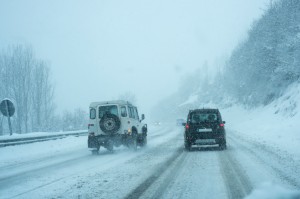
Hit and Run personal injury claims in British Columbia require injury claimants to name ICBC as a nominal defendant and prove that the unknown driver was at fault. In this hit and run bifurcated summary liability trial (Link v. Insurance Corporation of British Columbia,2014 BCSC 1765) the determination of liability was the sole issue before the Court.
The injury Claimant lost control and went into a ditch after his front windshield was blanketed with snow by a passing SUV. The driver of the SUV roared by the Claimant creating a big rooster tail of snow which completely covered the Claimant’s windshield. The SUV did not stop and left the scene of the accident. The issue was whether the action of the SUV in passing the Claimant and blanketing him with snow constituted negligence.
Sections 157-159 of the Motor Vehicle Act in British Columbia establishes a statutory duty of care on the driver of a vehicle overtaking another vehicle. Section 157 requires that the driver of an overtaking vehicle may only pass another vehicle on the left side “at a safe distance and must not cause or permit the vehicle to return to the right side of the highway until safely clear of the overtaken vehicle”. Section 159 states that “a driver of a vehicle must not drive to the left side of roadway when overtaking and passing another vehicle unless the driver can do so safely.”
In common law negligence the court must then determine:(a) whether the defendant owed a duty of care to the claimant;(b) if a duty existed, what standard of care was required and was the standard met;(c)did the failure to meet the standard of care cause the harm suffered;(d)did the claimant voluntarily accept the risk; and (e)was the claimant contributorily negligent? There is a very heavy onus on the driver of an overtaking vehicle to make sure that passing can be done in safety; particularly in poor road and weather conditions.
The driver of the SUV in this case did not respect the circumstances that the standard of care dictated. That driver was found to be in clear breach of the standard of care. The Judge found that the risk to the Claimant could have been avoided by the driver of the SUV by passing at a lower rate of speed and not returning to the slow lane abruptly.
Furthermore, no contributory negligence had been proven. The Claimant was in a smaller vehicle driving in a safe manner at low speed consistent with the difficult snow conditions. The act of tapping his brakes was found to be a reasonable reaction to losing total forward visibility.
The Court was satisfied therefore that the Claimant had proven on a balance of probabilities that the driver of the SUV was negligent.
Learn more about how to make a hit and run claim in British Columbia:
Posted by Personal Injury Lawyer Mr. Renn A. Holness, B.A. LL.B.
ISSUE: Should victims of a hit and run have to prove negligence?
